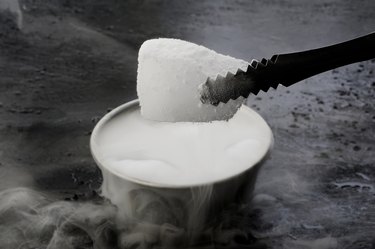
Dry ice is famous for the smoky effect it creates, often seen in haunted houses, specialty cocktails, movie special effects, science experiments, emergency preparedness and other contexts. With such a variety of applications, learning how to use dry ice can be helpful in a number of situations; especially important is understanding the risks and safety protocols.
Dry Ice Characteristics
Video of the Day
Dry ice is the solid, frozen form of carbon dioxide, which is normally gaseous at room temperature. However, unlike water ice, dry ice does not melt into a liquid: it converts directly from a solid to a gas in a process called sublimation. As a consequence, dry ice can do things like cooling drinks without watering them down as the gas simply escapes into the surrounding air. Hence, the term "dry" ice.
Video of the Day
However, dry ice has these properties because it is extremely cold: -109.3 degrees Fahrenheit (-78.5 degrees Celsius). For comparison, water ice is 32 degrees F (0 degrees C). Note that's +32F, not -32F, meaning that dry ice is 141 degrees F colder than water ice. This is why dry ice can be dangerous, or even fatal.
As dry ice sublimates, it releases pure carbon dioxide into the air. One of the reasons dry ice is dangerous: air is composed mostly of nitrogen (78 percent), some oxygen (21 percent) and only 0.035 percent carbon dioxide, with CO2 concentrations above 0.5 percent becoming dangerous for humans.
In enclosed or poorly ventilated spaces, dry ice can alter the atmosphere sufficiently to become dangerous or even fatal, especially lower to the ground as the CO2, cooler and heavier than the surrounding air, sinks to the bottom of the space. If stored in a smaller sealed space, dry ice can release enough CO2 to cause an explosion.
Additional Dangers of Dry Ice

In addition, dry ice is so cold that it burns and can easily cause frostbite. Momentarily touching your hand to dry ice is generally harmless, but even a few seconds of direct contact can cause burns and permanent damage.
Mild dry ice burns can be treated similarly to mild heat burns, with lukewarm water, but more serious burns and frostbite require medical attention. Ingesting dry ice is extremely dangerous, as it can cause internal burns and frostbite or even suffocation as it sublimates and releases CO2 inside the body. With all of these risks, it's important to understand how to handle dry ice.
How to Handle Dry Ice
For all the necessary and understandable cautions around dry ice, handling it safely is relatively straightforward. First and foremost, do not touch and do not allow others, such as children or customers, to touch dry ice directly. When handling dry ice, wear gloves and use tongs. In a pinch, thick oven mitts will suffice.
If you plan to chip the dry eye, wear full-coverage safety eyewear such as goggles or glasses with side protection. Handle dry ice in well-ventilated areas. If you are around dry ice and start experiencing shortness of breath or difficulty breathing, disorientation, confusion or headache, or see a bluish tint to your skin, move away from the dry ice to a well ventilated or outdoors area immediately.
One common use of dry ice is in emergency preparedness, such as when power is expected to be out longer than a freezer or refrigerator can keep perishables cold. Do not let dry ice directly contact the food you intend to keep cold. Wrap the dry ice in newspaper and keep wood, cardboard or layers of newspaper between the dry ice and any food below it. Most importantly, make sure the space it's in is not airtight, or the dry ice might cause an explosion.
Fun Uses of Dry Ice

Another popular use of dry ice is in cocktails and punches and many amateur drink makers wonder: Can you put dry ice in drinks? While the FDA does not prohibit the use of dry ice or liquid nitrogen in food preparation and service and many establishments use dry ice as a presentational element in beverages, all of the above cautions apply. Dry ice should not be ingested or allowed to touch the mouth.
Many bartenders will place a chunk of dry ice at the bottom of a drink to create the appealing smoky effect as patrons sip from the surface, or will put larger amounts of dry ice in punch or drink bowls that are then served without the dry ice. If dry ice is used in the preparation or presentation of a drink, it should be allowed to completely sublimate and vanish before the customer is actually served the drink. In addition to the danger of being touched or ingested, the dry ice could also overchill the drink or introduce undesired carbonation.
Finally, do not dispose of dry ice in the trash or down the sink, garbage disposal or toilet. It can explode or damage pipes and other infrastructure. Instead, leftover dry ice should be allowed to sublimate completely in a well-ventilated area, preferably outdoors where it won't come in contact with children or animals. Most blocks of dry ice available to individual consumers will completely sublimate in 24 hours in these conditions.